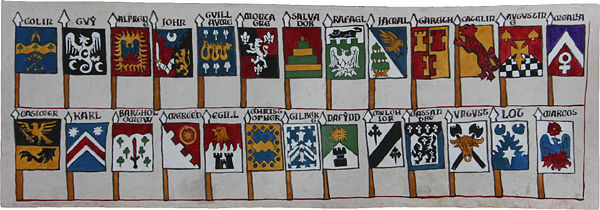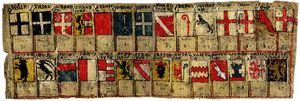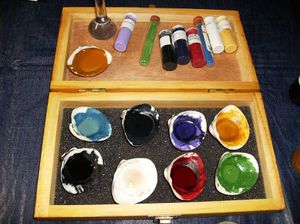Serjeayntes Roll
Below is documentation for an entry in Pentathlon 2009. The artists were Lachlan of Cromarty (layout, drawing and calligraphy) and Aliskye MacKyven Raizel (painting), and the entry was for Team Lyondemere. The item is an armorial roll of the Serjeayntes of Lyondemere current as of 01/2009. The roll is made of parchment, iron-gall ink and paint mixed from ground pigments and binders.
An Armorial Roll Based on Zurich Roll Fragment

In this project, we have chosen to create an armorial roll displaying the arms of the Serjeayntes de Lyondemere, warriors honored by the Barony of Lyondemere in the Society for Creative Anachronism. As a model for our armorial roll, we have chosen the so-called “Zurich Roll”.
This roll takes its name from its current location, the Burgerbibliothek Zürich (People's Library of Zurich). From the arms present, the document can be dated to ca. 1340, making it the oldest surviving roll of arms. The arms depicted are mainly from the area of Lake Constance, so we can assume it was painted in that region. Its original purpose is unknown.[1] The history of the document is unknown from the fourteenth through seventeenth centuries. Our oldest surviving record of ownership goes back to the early eighteenth century, when it was owned by Johann Jakob Schuchzer (1672-1733).[2]
This document is an “armorial roll” in the strictest sense. The manuscript is painted on thirteen strips of parchment sewn end-to-end to produce three, longer strips. The width of the strips is approximately 12.5cm, and the total length of the roll is 400.5cm.[3] It was originally longer. Surviving copies from sixteenth and eighteenth centuries include some additional portions which are now lost. [3]
The surviving document depicts four-hundred-fifty coats of arms with shield, helm and crest. In addition, there are twenty-eight arms of bishoprics depicted on rectangular banners flying from vertical lances.

We chose the fragment of the Zurich Roll depicting these banners as the model for this recreation. We chose this portion for two reasons:
- The absence of crests is more compatible with heraldic tradition in the Society, which restricts the display of crests to individuals of certain classes. More than half of the Serjeayntes are not entitled to display helm and crest
- The number of banners in the original, twenty-eight, nearly matches the number of Serjeayntes, twenty-six
The forename of each Serjeaynt occupies the space above each banner, between the lance-points. They are written in simple, Gothic capitals.[4] The arms in our recreation are placed from left to right in the order that each individual was admitted into the Serjeayntes.[5] At the left, Colin and Casimer are the “premiers of the order”, which conveniently placed “COLIN” in the same position as “KÖLN” in the original.
Three of the Serjeayntes do not have arms registered with the College of Arms of the Society for Creative Anachronism. These are Salvador, Catelin and Marcos. Rather than leave their banners blank, attributed arms have been devised for them. While not a common practice in the SCA, period heraldic artists frequently used attributed arms when the actual arms were not known or never existed. The artist of the Zurich Roll made use of this practice. For example, the arms of Portugal, depicted on another fragment of the roll, show an open door, or portal.[6] The attributed arms of Caitlin (top row, third from right) are patterned after the peculiar banner of “PASSOW” wherein the dragon upon the flag appears to grasp and bite at the staff. Salvador's banner makes reference to his Mexican persona, and Marcos' banner was designed based on consultation with Marcos himself.
In the original, there is notation below each banner. As this notation clearly was not written by the original artist, we have omitted it.
Wherever possible, materials and tools available to a heraldic artist of the fourteenth century have been used for this recreation. It is completed on parchment using a commercially-available, traditional, iron-gall ink and paint made from dry pigments and period binders.
When inking the document, I originally tried to use a quill I had on hand. I did some experiments writing and drawing with the quill on scraps of parchment. Unfortunately, I found the quill is cut to too wide a tip for the purpose of this project. As I lacked the confidence to re-cut the quill, I chose instead to use modern, steel-nib, dip pens for the finished product. While the tool was modern, the process itself, dipping the pen, and writing and drawing on the parchment, duplicates the methods of the original artist to a large degree.
It is clear that the artist did not use a straight edge to lay out lines for either letters or art. The shapes of the banners are not uniform, and letters are laid out in available space with little regard for formality. So I also put aside my rulers and squares and drew everything by hand.

I did take the precaution of drawing the banners first on a sheet of paper, then tracing the shapes onto the vellum in ink. The original artist could not have used this method. The fact that the original is painted on both sides of the parchment would make tracing impractical. However, he surely had more experience and comfort working with the materials than I do. My method compensates for my own, relative lack of experience, and this process produces an authentic result, free of evidence of under-drawing with pencil.
I did not, however, use tracing when writing the names. Instead, I examined the hand of the original (as best I could, given the poor source image quality) and practiced the letters for a time on both paper and on scraps of parchment. When I felt comfortable with the hand, I wrote the names directly onto the parchment without rules or under-drawing. The result, while very rough, is as faithful to the original as I can manage.
The paints were all made from dry pigments, using period methods, making an effort to try and match the colors of the exemplar roll. Lacking a reference that cites chemical analysis of the original work, the paint colors were chosen by eye without knowing what exact colors were used with the addition of the color purple which does not appear on the Zurich roll. The colors were taken from what I had on hand, specifically:

| Or – Spanish Golden Ochre | Argent – Bolognese Chalk |
| Gules – Alizarin Crimson | Azure – Azurite (with a small amount of Indigo added) |
| Vert – Chromium green | Purpure – Ultramarine Reddish Violet (Synthetic) |
| Sable – Ivory Black | Proper (Brown) – English Raw Sienna |
Each of the colors was ground using a glass muller on a ceramic slap with distilled water. Cennini cites the use of a porphyry as being the best for grinding colors and also recommends the use of "clean water, either from a river, a fountain, or a well" [7]. After grinding, each color was poured off into a scallop shell and the binder added. I used a combination of both gum Arabic and glair. The gum Arabic was made from soaking gum Arabic crystals overnight, and then straining the liquid through a couple of layers of cheesecloth. The glair was made from the white of an egg (free range eggs procured from a local farmers market), whipped into "snow" and left to settle over night. Each binder had a small amount of sugar added. I was concerned from previous tries at making paint that the pigments would rub off, but in the end I think I over-bound them and that more experimentation to get the proper amount of binder is necessary. After a little testing, the paints were left overnight to set.
The banners were each painted using several very fine paintbrushes. The paint was frequently cross-hatched on to the vellum in an attempt to make the colors smooth and even, though some of the colors did not cover as well as I would have hoped. The complexity of SCA arms made the painting rather nerve-racking compared to the relatively simple arms on the original banners.
I enjoyed the process very much, though next time I would certainly grind the paint colors longer and do quite a bit more experimentation before painting the final product.
Endnotes
- Bigalski, Gerrit, "The Zurich Roll of Arms - Die Wappenrolle von Zürich," introductory page
- Runge, Heinrich, Die Wappenrolle von Zürich : ein heraldisches Denkmal des vierzehnten Jahrhunderts, p.2
- Bigalski, Gerrit, "The Zurich Roll of Arms - Die Wappenrolle von Zürich," introductory page
- Drogin, Marc, Medieval Calligraphy: Its History and Technique, pp.141-3
- Society for Creative Anachronism, "Kingdom of Caid Order of Precedence"
- Neubecker, Ottfried, Heraldry: Sources, Symbols and Meaning, p.136
- Cennini, Cennino D'Andrea and Thomson, Daniel V. The Craftman's Handbook, Chapter 36
Bibliography
- Bigalski, Gerrit, "The Zurich Roll of Arms - Die Wappenrolle von Zürich," (http://www.silverdragon.org/HERALDRY/ZurichRolls/zroaen0.htm, Nov. 1996)
- Cennini, Cennino D'Andrea and Thomson, Daniel V. The Craftman's Handbook: "Il Libro Dell' Arte" (Dover Publications imprint, 1954)
- Clemens, Raymond and Graham, Timothy, Introduction to Manuscript Studies (Cornell University Press, 2007)
- De Hamel, Christopher, The British Library Guide to Manuscript Illumination, (University of Toronto Press, 2001)
- Drogin, Marc, Medieval Calligraphy: Its History and Technique, (Dover Publications, Inc., New York, 1980)
- Neubecker, Ottfried, Heraldry: Sources, Symbols and Meaning, (Macdonald & Co. under Black Cat imprint, 1988)
- Runge, Heinrich, Die Wappenrolle von Zürich : ein heraldisches Denkmal des vierzehnten Jahrhunderts (for Antiquarische Gesellschaft in Zürich, Published by Selbstverlag der *Gesellschaft; druck von D. Bürkli, 1860, Digitized by Google, 2008, http://books.google.com/books?id=zFssAAAAYAAJ)
- Society for Creative Anachronism, "Kingdom of Caid Order of Precedence," (Caid College of Heralds, http://herald.sca-caid.org/op/index.html)
- Ward, Christie, untitled web article (http://www.vikinganswerlady.com/ZurichRoll/)
Appendix
The Serjeayntes who are represented in this armorial roll are as follows:
Top Row:
- Colin Wynthorpe
- Guy de Coldrake
- Alfrede Raedwald of Devennport
- John Fettersson of the Misty Hills
- Guillaume MacMaelMicheil
- Montagne Maximilian de Lyon
- Salvador Juárez de Xochimilco
- Rafael Mercùrio
- Jamal Damien Marcus
- Gareth Nikodemos Somerset
- Catelin Avenel
- Augustine von Freiburg
- Mealla Caimbeul
Bottom Row: